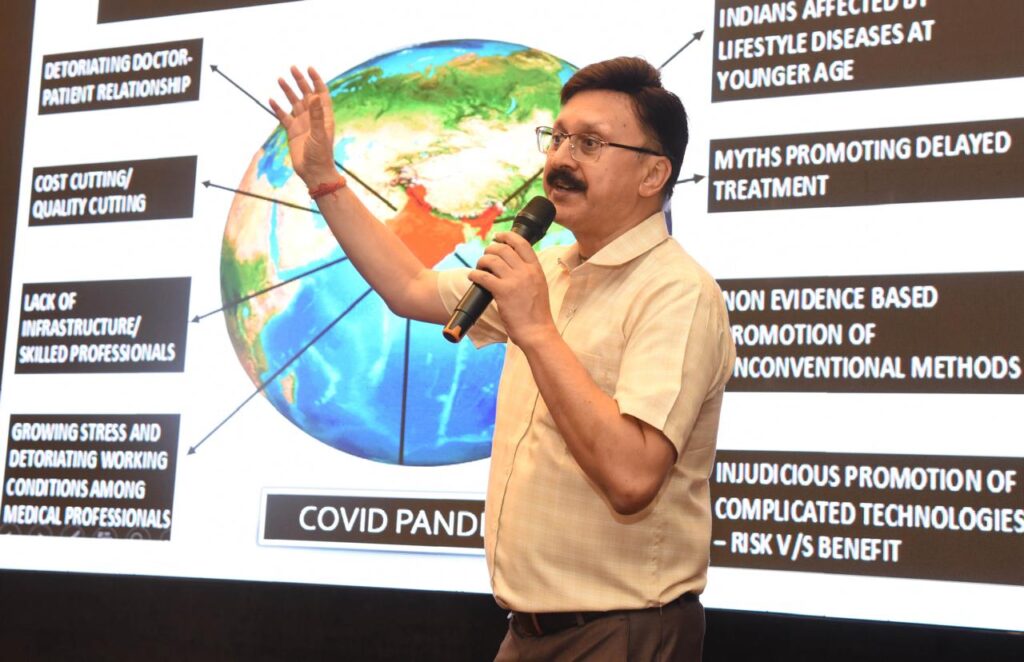
Chandigarh: The 3 days 15th annual Cardiomersion Global Conference 2025 on integrated approach to deliver comprehensive management of cardiovascular disease concluded here on Saturday. The 112 speakers took part in the conference, which was held in hybrid mode at Chandigarh and Rome.
The event served as a global platform for the discussion of emerging technologies, advanced surgical techniques, and integrated patient-centric care models in cardiovascular and thoracic surgery. Renowned surgeons, cardiologists, researchers, and innovators gathered to share insights, present breakthrough data, and envision the future of cardiac healthcare with a common goal, improving outcomes while minimizing invasiveness.
Dr. Deepak Puri, global chairman of Cardiomersion delivered two landmark presentations. In his first session, he introduced a novel modification of Uniportal Video-Assisted Thoracoscopic Surgery (UVATS), a technique that allows complex thoracic procedures to be performed through a single 3 cm incision. With specially designed retractors and a refined anterior-posterior approach, this modified UVATS offers direct visualization comparable to open thoracotomy, while minimizing postoperative pain, cost, and recovery time.
In his second talk, he addressed the management of rapidly worsening ischemic heart failure—a condition often seen in patients with multi-vessel coronary artery disease, present late after onset of heart attack and deteriorating rapidly but are ineligible for percutaneous interventions. He presented a study involving 361 such patients treated with urgent off-pump surgical revascularization.
Timely surgical intervention combined with optimized medical management offers a highly effective strategy for managing acute ischemic heart failure, Dr. Puri concluded.
Another keynote speaker, Dr. Johannes, cardiac surgeon from Pittsburgh USA, presented a visionary talk on how robotic technology will shape the future of minimally invasive cardiac surgery.
Dr. Johannes Bonatti described how robotics has been successfully applied to coronary bypass grafting, mitral valve repair, and is now being extended to more complex operations such as aortic valve replacement, septal myectomy, LVAD implantation, and even heart and lung transplantation. He discussed newly introduced surgical robots with modular arms, open consoles, enhanced tactile feedback, and capabilities for telesurgery.
In line with this transformative vision, Dr. Eric J. Lehr, minimally invasive cardiac surgeon at Swedish Heart and Vascular Institute Seattle USA, delivered a dynamic presentation on the future of minimally invasive cardiac surgery, focusing on the integration of robotics, artificial intelligence (AI), and emerging innovations.
He also illustrated how robotic systems like the da Vinci platform have expanded the possibilities for minimally invasive procedures such as mitral valve repair and coronary bypass surgery, enabling greater precision and patient comfort.
Dr. Nidhi Puri Dean (Examination) and Professor & HOD, Department of Anatomy, AIIMS Bilaspur HP shared her findings on anatomical variations in the internal thoracic artery, a crucial vessel for coronary artery bypass grafting. Her presentation emphasized the need for careful preoperative imaging and anatomical assessment when planning bilateral harvesting to avoid complications and optimize outcomes.
Among others Dr. Amitabh Satsangi assistant professor in department of CTVS AIIMS , New Delhi , Dr. Sudheer Verma assistant professor in department of CTVS AIIMS , New Delhi , Dr. Surabhi Puri, Assistant Professor of Community Medicine at Maulana Azad Medical College, New Delhi and Dr. Manoj Sahu Professor in Intensive Care for CTVS including Cardiac Transplantation Program in AIIMS, New Delhi also shared their valuable findings and views.
Leave a Reply